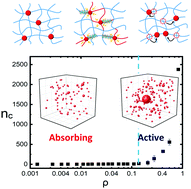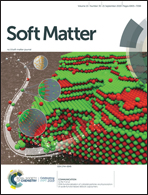Absorbing–active transition in a multi-cellular system regulated by a dynamic force network†
Abstract
Collective cell migration in 3D extracellular matrix (ECM) is crucial to many physiological and pathological processes. Migrating cells can generate active pulling forces via actin filament contraction, which are transmitted to the ECM fibers and lead to a dynamically evolving force network in the system. Here, we elucidate the role of this force network in regulating collective cell behaviors using a minimal active-particle-on-network (APN) model, in which active particles can pull the fibers and hop between neighboring nodes of the network following local durotaxis. Our model reveals a dynamic transition as the particle number density approaches a critical value, from an “absorbing” state containing isolated stationary small particle clusters, to an “active” state containing a single large cluster undergoing constant dynamic reorganization. This reorganization is dominated by a subset of highly dynamic “radical” particles in the cluster, whose number also exhibits a transition at the same critical density. The transition is underlaid by the percolation of “influence spheres” due to the particle pulling forces. Our results suggest a robust mechanism based on ECM-mediated mechanical coupling for collective cell behaviors in 3D ECM.



 Please wait while we load your content...
Please wait while we load your content...